ホームページ >運用・保守 >Linuxの運用と保守 >Linux ディスクのパーティショニングとマウント
Linux ディスクのパーティショニングとマウント
- Linux中文社区転載
- 2023-08-01 17:19:072023ブラウズ
 #
#
#Linux ディスクのパーティショニングとマウント
#Linux パーティショニング#原理の紹介
-
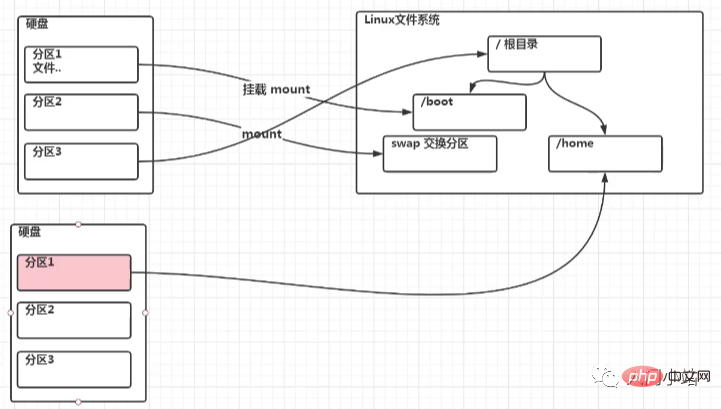
##1. Linux ハードディスクは IDE ハードディスクと SCSI ハードディスクに分けられますが、現在は基本的に SCSI ハードディスクです。 2. IDE ハードディスク の場合、ドライブ識別子は「hdx~」です。ここで、「hd」はパーティションが配置されているデバイスのタイプを示します。これは、IDE ハード ドライブを指します。 「x」はディスク番号(aは基本ディスク、bは基本スレーブディスク、cは補助マスターディスク、dは補助スレーブディスク)、「~」はパーティションを表し、最初の4つのパーティションを表します1 ~ 4 の番号で表されます。5 から始まるプライマリ パーティションまたは拡張パーティションが論理パーティションです。たとえば、hda3 は最初の IDE ハードディスク上の 3 番目のプライマリ パーティションまたは拡張パーティションを表し、hdb2 は 2 番目の IDE ハードディスク上の 2 番目のプライマリ パーティションまたは拡張パーティションを表します。 3. SCSI ハードディスク の場合、「sdx~」とマークされており、SCSI ハードディスクは、パーティションが配置されているデバイスのタイプを表す「sd」で、残りは IDE ハードディスクと同じです (x は、それぞれ 1 番目、2 番目、3 番目、および 4 番目のハードディスクに対応する abcd にすることができます)。
すべてのデバイスのマウント ステータスを表示
コマンド: lsblk または lsblk - f
[root@kongchao03 ~]# lsblkNAME MAJ:MIN RM SIZE RO TYPE MOUNTPOINTsda 8:0 0 20G 0 disk ├─sda1 8:1 0 1023M 0 part /boot├─sda2 8:2 0 17G 0 part /└─sda3 8:3 0 2G 0 part [SWAP]sr0 11:0 1 729.9M 0 rom /run/media/root/20210907_143734[root@kongchao03 ~]#


##ここで、sda1、2、および 3 はそれぞれ、ハードディスクの最初のパーティションと 2 番目のパーティション...
取り付けケース
ステップ 1: 新しいハードディスクを作成する
##仮想マシンのメニューで、ハードディスクを追加するように設定します。完了後、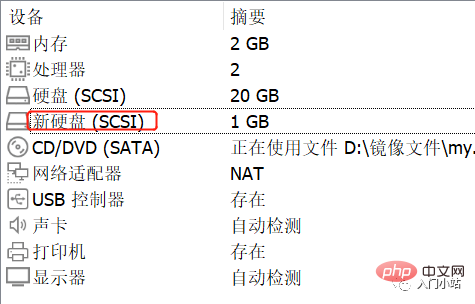
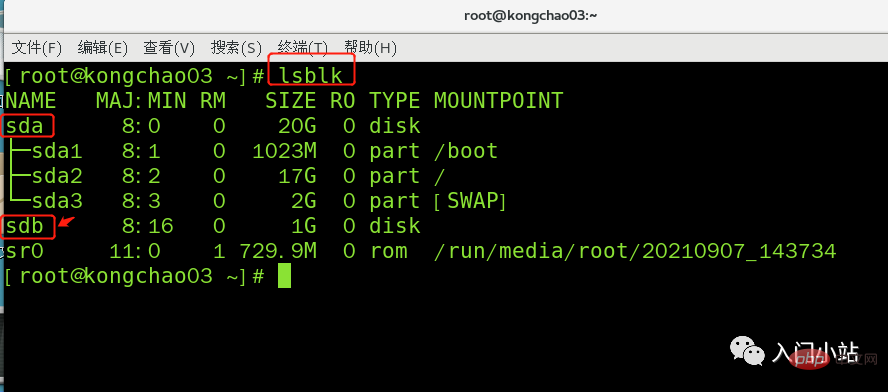
操作ステップを表示します2: 仮想マシンのハードディスク パーティション
パーティションの手順: fdisk /dev/sdb
m コマンド一覧表示 p fdisk -l #n と同じディスク パーティションを表示します 新しいパーティションを追加します #d パーティションの削除 ## w 書き込んで終了
手順: パーティションを開始した後に n を入力し、新規追加a パーティションを選択してから p を選択すると、パーティション タイプはプライマリ パーティションになります。两次回车默认剩余全部空间,最后输入 w 写入分区并退出,若不保存退出输入 q
[root@kongchao03 ~]# fdisk /dev/sdb欢迎使用 fdisk (util-linux 2.23.2)。 > 更改将停留在内存中,直到您决定将更改写入磁盘。使用写入命令前请三思。 > Device does not contain a recognized partition table>> 使用磁盘标识符 0xdf03b737 创建新的 DOS 磁盘标签。 命令(输入 m 获取帮助):m 命令操作 a toggle a bootable flag b edit bsd disklabel c toggle the dos compatibility flag d delete a partition g create a new empty GPT partition table G create an IRIX (SGI) partition table l list known partition types m print this menu n add a new partition o create a new empty DOS partition table p print the partition table q quit without saving changes s create a new empty Sun disklabel t change a partition's system id u change display/entry units v verify the partition table w write table to disk and exit x extra functionality (experts only)命令(输入 m 获取帮助):nPartition type: p primary (0 primary, 0 extended, 4 free) e extendedSelect (default p): p分区号 (1-4,默认 1):1起始 扇区 (2048-2097151,默认为 2048):将使用默认值 2048Last 扇区, +扇区 or +size{K,M,G} (2048-2097151,默认为 2097151):将使用默认值 2097151分区 1 已设置为 Linux 类型,大小设为 1023 MiB命令(输入 m 获取帮助):wThe partition table has been altered!Calling ioctl() to re-read partition table.正在同步磁盘。[root@kongchao03 ~]#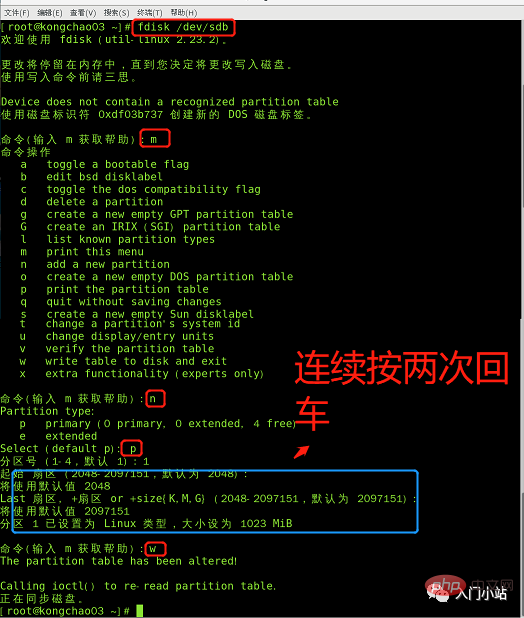
步骤 3:虚拟机硬盘分区格式化
格式化指令:mkfs -t ext4 /dev/sdb1
mkfs -t ext4 /dev/sdb1lsblk -f
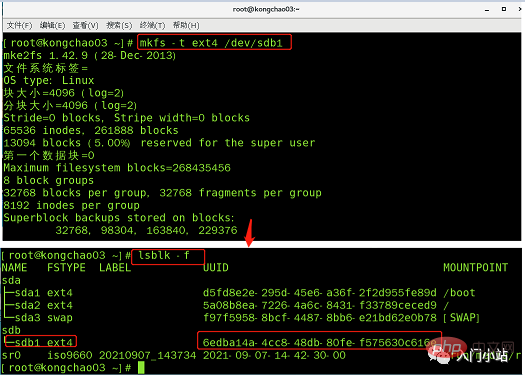
步骤 4:将磁盘挂载到根目录下 newdisk 目录下
也可以到其他目录下挂载:将一个分区与一个目录联系起来,
mount 挂载
牛逼啊!接私活必备的 N 个开源项目!赶快收藏
挂载语法:mount 设备名称 挂载目录 (挂载目录是任意的)
[root@kongchao03 ~]# cd / [root@kongchao03 /]# mkdir newdisk [root@kongchao03 /]# mount /dev/sdb1 /newdisk [root@kongchao03 /]# lsblk -f
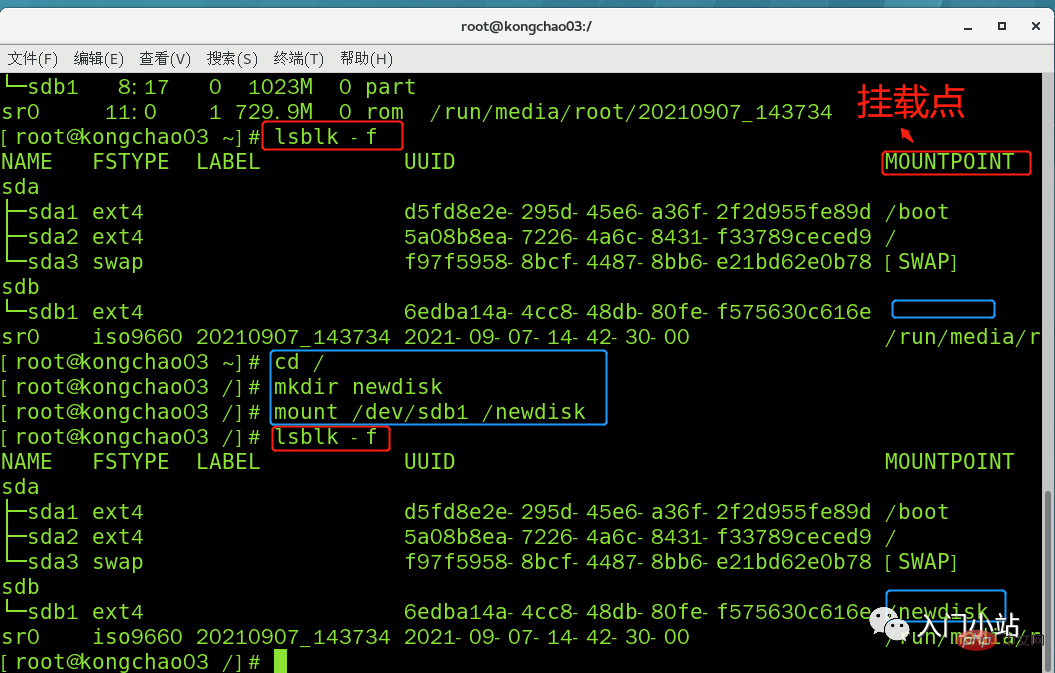
cd 进入挂载点,在其中创建文件,实则是在分区上新建了一个文件
linux 根下的存放只是目录,真正存放数据还是在硬盘中的分区
umount 取消挂载
umount /dev/sdb1 lsblk -f
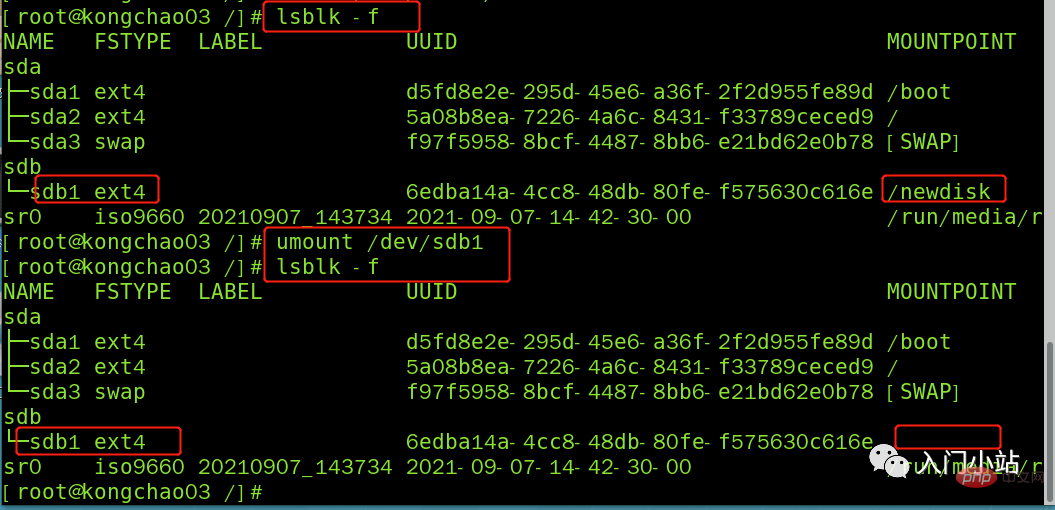
步骤 5:实现永久挂载(即重启不消失)
永久挂载:通过修改/etc/fstab 实现挂载
添加完成后执行mount -a 或 reboot 即可生效
[root@kongchao03 /]# vim /etc/fstab [root@kongchao03 /]# mount -a
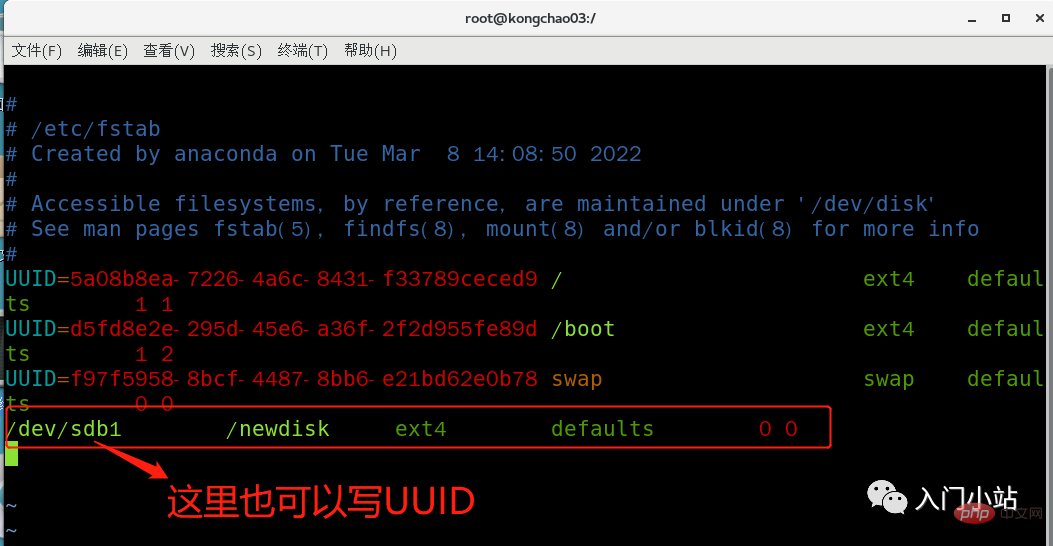
df -h 查询磁盘使用情况
[root@kongchao03 ~]# df -h 文件系统 容量 已用 可用 已用% 挂载点 /dev/sda2 17G 5.8G 11G 37% / devtmpfs 978M 0 978M 0% /dev tmpfs 993M 0 993M 0% /dev/shm tmpfs 993M 9.0M 984M 1% /run tmpfs 993M 0 993M 0% /sys/fs/cgroup /dev/sdb1 991M 2.6M 922M 1% /newdisk /dev/sda1 991M 128M 797M 14% /boot tmpfs 199M 20K 199M 1% /run/user/0 /dev/sr0 730M 730M 0 100% /run/media/root/20210907_143734 [root@kongchao03 ~]#
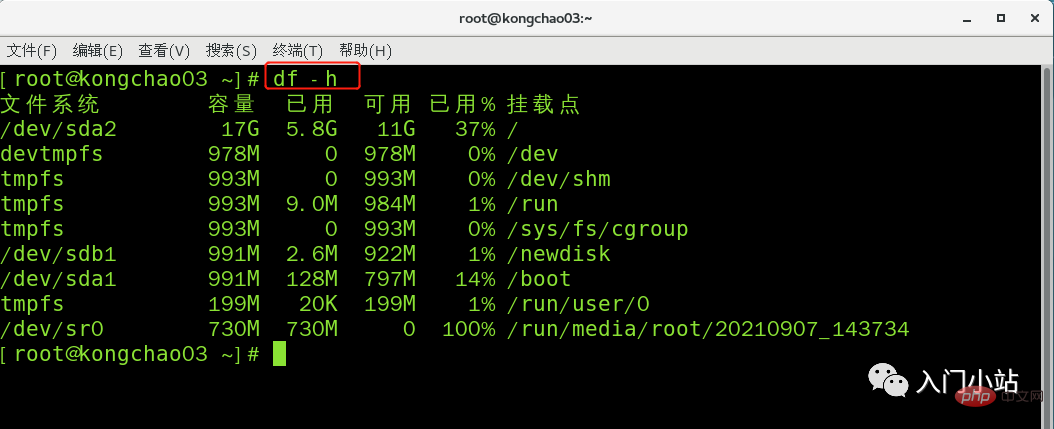
#コマンド: du [パラメータ] / directory (指定されたディレクトリのディスク使用量をクエリします。デフォルトは現在のディレクトリです)
| #パラメータ |
意味 |
| -s |
サイズの概要指定したディレクトリの |
| -h | ##単位は測定|
|
|
|
参数可以联合使用示例:查询 / opt 目录的磁盘占用情况,深度为 1
[root@kongchao03 /]# cd /opt [root@kongchao03 opt]# ls rh [root@kongchao03 opt]# du -h --max-depth=1 /opt 4.0K /opt/rh 8.0K /opt [root@kongchao03 opt]#
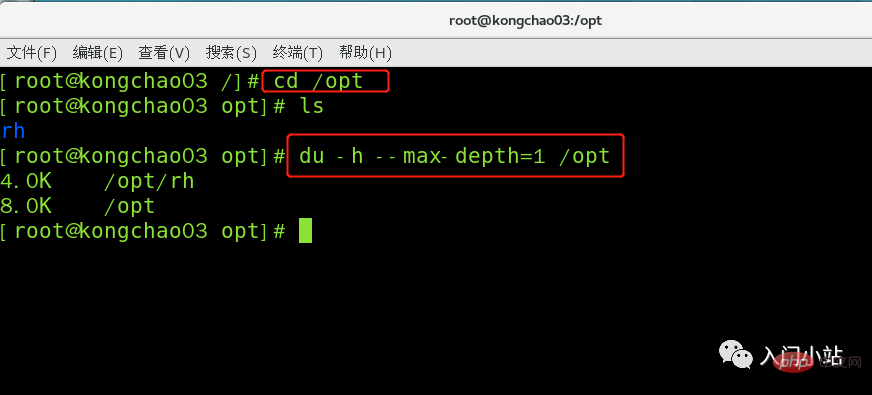
[root@kongchao03 opt]# du -hac --max-depth=1 /opt 4.0K /opt/rh 8.0K /opt 8.0K 总用量

以上がLinux ディスクのパーティショニングとマウントの詳細内容です。詳細については、PHP 中国語 Web サイトの他の関連記事を参照してください。
声明:
この記事はLinux中文社区で複製されています。侵害がある場合は、admin@php.cn までご連絡ください。

